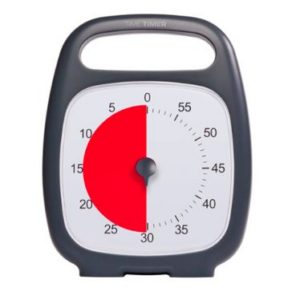
Would your organization like to hold meetings that are more efficient, more productive, and even more enjoyable?
I’ve interviewed hundreds of billionaires, famous entrepreneurs, and leaders of the most successful companies in the world. In analyzing the meeting culture in these organizations, a few things began to stand out.
Google Ventures’ Secret Weapon
Jake Knapp, design partner at Google Ventures, is an advocate for using a physical clock to count down the time remaining in a meeting. He discovered a specific type of timer, called the Time Timer, while visiting his child’s classroom.
Teachers have been known to call it “The Magic Clock.” The Time Timer is battery powered and large enough to be seen by meeting participants from across a room. A red disc silently spins, showing the amount of time remaining. Why not just set a timer on your smartphone? As Knapp wrote on Medium:
“The Time Timer is way better than a timer app on a screen. Because it’s physical, it’s easier to adjust and set, and absolutely impossible to ignore.”
Would your organization like to hold meetings that are more efficient, more productive, and even more enjoyable?
I’ve interviewed hundreds of billionaires, famous entrepreneurs, and leaders of the most successful companies in the world. In analyzing the meeting culture in these organizations, a few things began to stand out.
Google Ventures’ Secret Weapon
Jake Knapp, design partner at Google Ventures, is an advocate for using a physical clock to count down the time remaining in a meeting. He discovered a specific type of timer, called the Time Timer, while visiting his child’s classroom.
Teachers have been known to call it “The Magic Clock.” The Time Timer is battery powered and large enough to be seen by meeting participants from across a room. A red disc silently spins, showing the amount of time remaining. Why not just set a timer on your smartphone? As Knapp wrote on Medium:
“The Time Timer is way better than a timer app on a screen. Because it’s physical, it’s easier to adjust and set, and absolutely impossible to ignore.”
Walk It Out
In 1999, a team of psychologists conducted research on the difference between sit-down and stand-up meetings across 56 different groups. As reported in the Journal of Applied Psychology: Sit-down meetings were 34% longer than stand-up meetings, but they produced no better decisions than stand-up meetings.
In a different study, researchers at Washington University in St. Louis determined that standing meetings were far better than sit-down meetings in terms of outcomes. They reported in Social Psychological & Personality Science that stand-up meetings led to better collaboration and less possessiveness of ideas, higher levels of engagement, and more problem-solving creativity.
Famous entrepreneur Richard Branson isn’t into traditional meetings either. As he wrote in his blog:
“One of my favourite tricks is to conduct most of my meetings standing up. I find it to be a much quicker way of getting down to business, making a decision and sealing the deal. When given the opportunity I often like to take things a step further—literally, with a walking meeting.”
In addition to Branson, Steve Jobs, Mark Zuckerberg, and Jack Dorsey have all been known to hold an affinity for walking meetings.
10-Minute Meetings
Should your meetings default to 30 minutes or one hour?
In an interview with Bloomberg Business in 2006, Marissa Mayer (who was with Google at the time) told the interviewer that she holds up to 70 meetings a week. The only way she could cram them all in was to break down the “30-minute” block into small meetings, sometimes as few as five or 10 minutes each.
Richard Branson spoke openly on his blog about his aversion to the traditionally timed meeting, saying that “It’s very rare that a meeting on a single topic should need to last more than 5-10 minutes.”
Is 10 minutes a bit too short for you? Ryan Delk, who leads growth at E-commerce and digital distribution company Gumroad defaults to 20 minutes:
“The default length of a meeting or call—both internally and externally—should be 20 minutes; anything longer should be an exception… Even if you’re just moving from 30-minute meetings to 20-minute meetings, you can fit in 4-6 more meetings, calls, or appointments in a day.”
The exact number of minutes isn’t important; the principle of shorter meetings is.
Design An Effective Agenda
The most successful people know that effective meetings begin with effective agendas, which are circulated in advance. Secrets to creating effective agendas include the following actions:
- Seek input on the agenda from participants before the meeting, so new topics don’t crop up and derail the primary goal.
- Clearly state the purpose of the meeting.
- Clearly state who the facilitator is.
- Identify all invited participants: The fewer the better, but you also want to make sure a key person isn’t being forgotten. Google tries to limit meeting participants to ten or fewer. Steve Jobs was known to throw people out of the room if they couldn’t come up with a good reason for being there.
- List agenda topics as questions whenever possible in order to focus the participants on decision-making.
- Attach time estimates to each agenda item so participants can monitor the progress and pace of the meeting. (Make sure the estimates are realistic.)
If you find your company is in a meeting rut, trying a few of these methods might be just the thing to save time , inspire creativity, and increase the flow of productivity.
—
Kevin Kruse is the author of 15 Secrets Successful People Know About Time Management and How Millionaires Plan Their Day: A 1-Page Tool.
Photo: Time Timer/Time Timer





